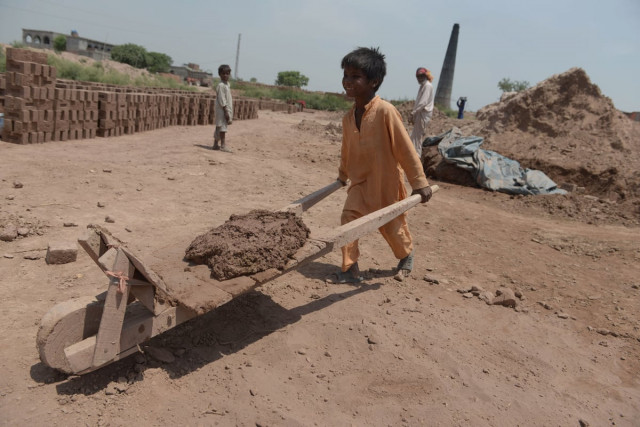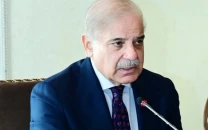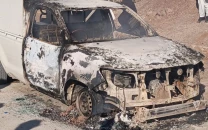Pakistan ranks sixth on Global Slavery Index
Over 2 million people in Pakistan are trapped in modern slavery

According to the report released worldwide on Monday, Pakistan not only ranks sixth in terms of the prevalence of modern slavery, it is host to the third highest population of enslaved people in the world.
Some 2 million Pakistanis – roughly 1.130% of the country’s population – especially children and bonded labourers, are thought to be enslaved, according to the report.
The report defines modern slavery as involving “one person possessing or controlling another person in such a way as to significantly deprive that person of their individual liberty, with the intention of exploiting that person through their use, management, profit, transfer or disposal.”
According to new methodology adopted by the organisation to gauge modern slavery, some 35.8 million people are currently trapped in modern-day slavery, more than originally thought.
"There is an assumption that slavery is an issue from a bygone era. Or that it only exists in countries ravaged by war and poverty," said Andrew Forrest, chairman of the Australian-based Walk Free Foundation which produced the report.
Situation in Pakistan
Terming debt-bondage as the most prevalent form of modern slavery in Pakistan, the report identified Punjab and Sindh as hotspots of bonded labour, with brick making, agriculture, and carpet weaving industries leading destination for such ‘slaves’.
According to the report, Pakistan ranks sixth on index in terms of prevalence in the country with 1.130 per cent of total population trapped under modern slavery.
The situation gets worse in when gauged in terms of number of enslaved in the country. With over 2 million people ‘enslaved’, Pakistan is ranked third on the index by number of people.
By contrast, Pakistan is behind India which leads the index in terms of enslaved people with 14.286 million people trapped in modern slavery (1.141 per cent of population with a rank of seven on prevalence index). China is ranked second on index in terms of enslaved people with 3.241 million people trapped in modern slavery (0.239 per cent of the population with a rank of 109 on the prevalence index).
Citing a recent media report, which estimated that the brick kiln industry in Pakistan employs around 4.5 million people across the country, the index said that the majority of brick kiln workers in Punjab are bonded labourers. The report further claims that although brick kilns now fall under provincial labour departments owing to the 18th amendment, half of the approximately 10,500 brick kilns in Punjab remain unregistered.
Decrying provincial governments’ lack of interest, despite the devolution of powers to the provinces, including responsibility for labour, child protection, and women’s protection after the 18th amendment in the Constitution, the report said that there is no single national-level body exists to oversee a coordinated response to the modern slavery challenges that Pakistan faces.
Cross-border human trafficking remains under the purview of the Federal Investigation Agency (FIA) of the Ministry of Interior and Narcotics Control, but there is no national level mechanism to address internal trafficking, said report.
It also referred to the Human Rights Commission of Pakistan’s report which claims that in Sindh and Punjab provinces some bonded labourers in brick kilns are “either kept in captivity by armed guards or their family members become virtual hostages.”
The report identifies unofficial work contracts between farmers and landlords in Sindh as the prime cause of slavery. Farmers, who are referred as ‘Hari’ under these unofficial contracts, are required to give up their entire yield to the landlords who employ them and are paid only in produce. In order to meet living costs beyond food and shelter, these farmers are forced to borrow money from their landlord, which reinforces the cycle of poverty, debt and forced labour.
It further reveals that approximately 10 million child workers exist in Pakistan out of which 3.8 million are aged between five and 14 years old.
The report also identified extreme poverty and unemployment as a major reason for families selling their children into commercial sexual exploitation; some of the children sold as young as 10 years old. Despite the social stigma and shame associated with commercial sex in the country, local NGOs have noted a rise in forced prostitution and commercial sexual exploitation of children.
The trafficking of men and women for forced labour, sexual exploitation and forced marriages to suitors from the Gulf and Europe have also been identified as a contributing factor in the continuation of modern slavery in the country.
Alarmingly, the report claims that as many 69.5 per cent of total population remains vulnerable to modern slavery owing to weak rule of law, wide spread corruption, and poverty reinforced political, social, and economic structures of modern slavery in the country.
The report proposed that a single agency, with Cabinet-level representation of the federal and provincial governments, create a single, integrated national strategy to end slavery, with an appropriate plan and budget. The report further recommended that the government enforce registration and regulation of brick kilns and other workplaces and payment of the minimum wage to brick kiln and other workers.
Last year, Pakistan was ranked third on the list, though a number of new countries have been added and the methodology has been changed since then.
Situation around the world
2014 Global Slavery Index (GSI), which covers 167 countries, said modern slavery contributed to the production of at least 122 goods from 58 countries.
The International Labour Organisation (ILO) estimates profits from this forced labour are $150 billion (120 billion euros) a year.
"From the Thai fisherman trawling fishmeal, to the Congolese boy mining diamonds, from the Uzbek child picking cotton, to the Indian girl stitching footballs... their forced labour is what we consume," read the report.
The biggest offender, with the highest proportion of its population enslaved, remains the west African nation Mauritania, where slavery of black Moors by Berber Arabs is an entrenched part of society.
Mauritania has anti-slavery legislation but it is rarely enforced and a special tribunal set up in March has yet to prosecute any cases, the report said.
In second place was Uzbekistan where, every autumn, the government forces over one million people, including children, to harvest cotton.
Countries like Qatar in the Middle East were a major destination for men and women from Africa and Asia who are lured with promises of well-paid jobs only to find themselves exploited as domestic workers or in the construction industry.
The countries doing the most to combat the problem were the Netherlands, Sweden, the United States, Australia, Switzerland, Ireland, Norway, the United Kingdom, Georgia, and Austria.
Europe, while at the bottom of the list -- with Iceland and Ireland the best ranked -- has 566,000 people involved in forms of modern slavery, with people trafficked into Ireland to grow cannabis, or forced into begging in France.
"Trafficking for commercial sexual exploitation accounted for almost 70 per cent of identified victims while trafficking for forced labour accounted for 19 per cent," read the report.
"The global economic crisis and austerity measures of the EU have meant that increasing numbers of Bulgarians and Romanians migrate in search of highly paid jobs. Some of these workers can be tricked or coerced into situations of exploitation."
The highest numbers of modern slaves were found in India with an estimated 14.29 million enslaved.
However the Index said India had recently taken important steps to combat the problem, strengthening its criminal justice framework through legislative amendments and increasing the number of its Anti-Human Trafficking Police Units.
Africa faces some of the biggest challenges, the report said, with armed forces and rebel groups from Somalia to the Central African Republic using child soldiers to mineral-rich Zambia, Angola, and the Democratic Republic of the Congo forcing children and adults to "labour in dangerous mines."
Nigeria is a major source of human trafficking to Europe. In one example, Nigerian women get trapped in a cycle of debt bondage in the Italian sex industry.
"These findings show that modern slavery exists in every country. We are all responsible for the most appalling situations where modern slavery exists and the desperate misery it brings upon our fellow human beings," said Forrest.


















COMMENTS
Comments are moderated and generally will be posted if they are on-topic and not abusive.
For more information, please see our Comments FAQ